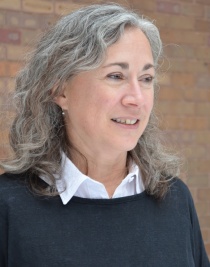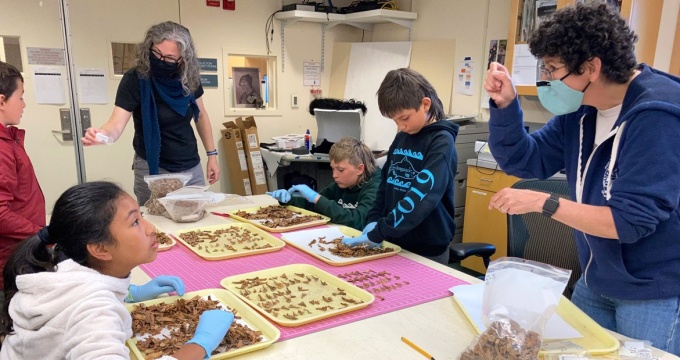New and Noteworthy
Caroline Funk awarded NSF grant focused on ocean mercury
Dr. Caroline Funk and Dr. Virginia Hatfield mentoring culture campers during fish bone sampling in the MOTA lab, Dutch Harbor. August 2021. Photo by Nicole Misarti, courtesy of the Museum of the Aleutians (MOTA).
The National Science Foundation, Office of Polar Programs, has awarded Caroline Funk (The Baldy Center and UB Department of Anthropology) and her colleagues at University of Alaska Fairbanks a 5-year, $2.6m research project: “Collaborative Research: Mercury Dynamics from the Holocene to the Anthropocene: Tracking Aleutian Mercury in Ocean Species important to Native Alaskan Diets” (PI Avery, coI Misarti, coI Rea NSF-ARCSS/ASSP 1935816; PI Funk ARCSS/ASSP 1935823). The interdisciplinary team of scientists, including paleoecologists, archaeologists, volcanologists, physiologists, and toxicologists, utilizes archaeological and historical collections to advance our understanding of changes in the dynamics of mercury accumulation in Arctic food webs. They investigate changes in environmental mercury dynamics by analyzing the mercury content of bones from predator species important to Indigenous Unangan communities in the Aleutian Islands and commercial fishing in the north Pacific Ocean and southern Bering Sea. Learn more: Aleutian Mercury Dynamics (uaf.edu)
Research Background
Excerpt from the Aleutian Mercury Dynamics project website:
Mercury is one of the top 10 contaminants of concern for human health, with estimates that between 1.5 to 17/1000 children in coastal fishing communities worldwide exhibit toxic health effects from Hg.
Northern coastal communities are especially vulnerable to the effects of mercury contamination due to their reliance on marine ecosystems for sociocultural, economic, and subsistence resources. Mercury in high northern latitudes accumulate from sources both natural (volcanos, forest fires, and melting permafrost) and anthropogenic (distant industrial activities transported to the region).
This interdisciplinary 5-year study aims to investigate ancient and historical mercury dynamics in the Aleutian Islands to understand natural fluctuations of environmental mercury prior to the industrial revolution. We are examining bone from ancient Steller sea lion, Northern fur seal, and cod harvested and consumed by ancestral Unangan communities in the Aleutian Islands.

Caroline Funk, PhD, Associate Director, The Baldy Center; Research Assistant Professor, Department of Anthropology, University at Buffalo
We handed out cod premaxillas, distinctive mouth parts that are easy to find in the massive fish bone collections. We talked about fish trophic positioning and estimating fish size with premaxilla measurements... The kids were doing scientific research with us, and they were putting pieces together."
—Caroline Funk, PhD
"Rain Day Cod Hunt"
The project website features a blog by Caroline Funk, which begins:
"I’m sitting in the Anchorage airport waiting for my long flight home to University at Buffalo as I write this and reflecting on the intense experience after months of pandemic delays for research. I am certain I touched more than a million fish and sea mammal bones as we worked our way through hundreds of bags of fish and sea mammal faunal remains from two villages lived in by ancestral Unangax 2000-3500 years ago. The sites were excavated in the late 1990s and early 2000s, and the materials are housed at MOTA.
Our second week coincided with Camp Qungaayux^, the annual culture camp for local kids. MOTA’s executive director, Virginia Hatfield, asked us to help out, and so we worked with museum staff for a few morning and afternoon sessions at the Agnes Beach site (UNL-046) excavation. The culture camp kids excavated and screened, participating in the careful archaeological methods we use to learn about past people and ways of living. They seemed intrigued by the idea that adults would lie on the ground in mucky rain gear and dig with teeny tiny trowels and dust pans. Kids are pretty adaptable evidently, and after staring big eyed for a bit, they had at it, finding rocks and flakes and greasy stains where people cooked dinner a few thousand years ago.
But then it rained.
“They’re coming to the museum lab,” Virginia Hatfield announced with a little bit of drama when it was certain the excavation was rained out. “Ok,” I told her after a small anxiety lurch, “we can work with that.” Nicole and I prepared trays for sorting, weighed and prepped bags of archaeological fish remains, set aside cod bone specimens for comparison, and practiced talking about biogeochemical analysis of fish bones in fourth grade language. We masked up and waited for the stampede of kid energy.
They arrived, cautiously interested and more like careful fawns than stampeding bison, trapped by circumstance to endure what was on offer."

